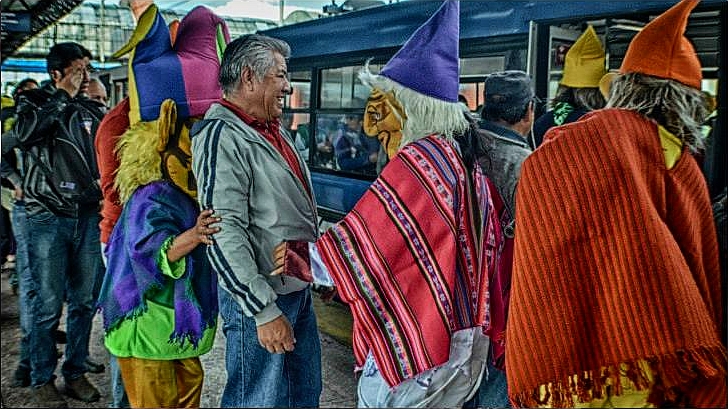
The game of the unexpected. Selected project in Art in the Trolley.
The time spent moving from one place to another in a large city tends to take up lost time, so much so that some consider the interconnected systems’ train cars or buses as non-places, much like the stations that make up the systems. But in Quito, Ecuador, Arte en el Trole (Art in the Trolley) [es] decided to bring a bit of art and culture to these civic spaces, which in Quito are represented by the Trolleybus or integrated bus transportation system.
Art in the Trolley began in 2006 and according [es] to their own words:
es un proyecto independiente que desde la práctica, ha posibilitado la democratización de la cultura a través del arte y sus diversas formas de expresión llevando propuestas de artistas locales, nacionales y extranjeros a presentar sus obras en nuevos espacios, beneficiando de forma directa a quienes lo habitan y que se encotraban excluidos de la riqueza cultural y artisticas que se desarrolla en el Ecuador y el mundo.
It is an independent project that, since its practice, has enabled the democratization of culture through art and its diverse forms of expressions, taking proposals from local, national, and foreign artists to present their works in new spaces, directly benefiting those who live here and find themselves excluded from the artistic and culture richness that is developing in Ecuador and the world.
In May of this year, I had the opportunity to visit them and speak with Daniel Pazmiño, who was kind enough to tell us about the history and activities of Art in the Trolley.
Art in the Trolley's objective, again in their own words, is “to establish a platform that spreads art and culture within the reach of those who live in the city. The artistic interventions carried out in the stations are proposals from multiple artists, creators, managers, leaders, organizations, etc., where they demonstrate mastery of the art that they practice, as the characteristics of the system requires it (the trolley mobilizes over 250,000 people per day)”.
In the following video, Daniel tells us about some of the speeches and performances carried out by the organization in the Trolleybuses or their stations:
Currently, Art in the Trolley has expanded [es] its activities beyond the Trolleybus system and “works in conjunction with students and representatives from high schools, universities, neighborhoods, etc., thereby promoting and strengthening the creation, production, spreading, and circulation of cultural property and allowing for the construction of superb spaces for an intercultural dialogue that aims to strengthen an inclusive cultural policy.”
In the last video with Daniel, he talks to us about the democratization of public spaces in Quito via the Art in the Trolley project.
To get an idea of Art in the Trolley's activities and involvement, we are sharing two videos below. The first is a collection of photos of the organization's main activities in 2013:
The second video is entitled “Dream raid on the Trolleybus” and was recorded live in one of the Quito trolleybus cars during one of Art in the Trolley's artistic interventions.
Before concluding, it is worth remembering what Daniel mentioned — that Art in the Trolley's call for artistic and cultural projects is open and ongoing, so groups in Latin America now know. You can see more videos from Art in the Trolley [es] on their YouTube [es] channel and by following them on Facebook [es] and Twitter [es].







3 comments